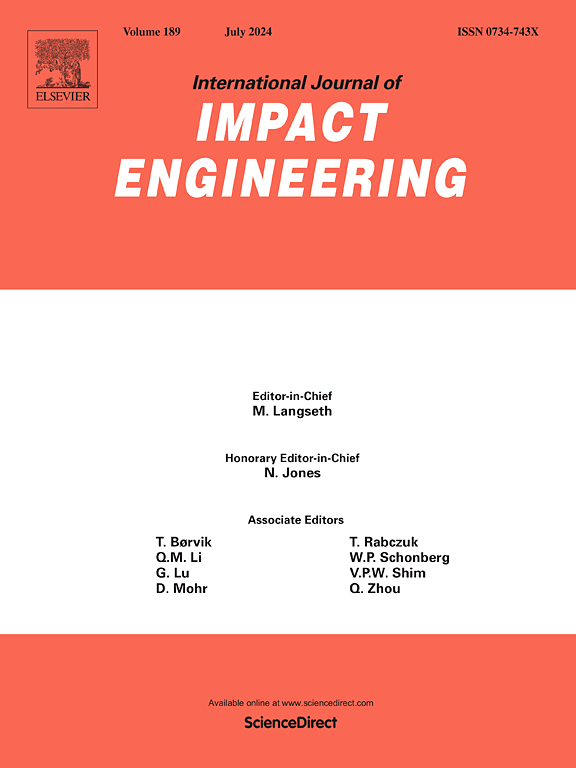Impact response of 3D printed cornstalk-inspired structures: The effect of indenter shape on penetration
IF 5.1
2区 工程技术
Q1 ENGINEERING, MECHANICAL
International Journal of Impact Engineering
Pub Date : 2024-10-10
DOI:10.1016/j.ijimpeng.2024.105143
引用次数: 0
Abstract
This paper reports the mechanical response and damage tolerance of 3D-printed cornstalk-inspired structures subjected to impact loading. Specimens were subjected to dynamic indentation tests at multiple impact energies with flat, hemispherical, and conical indenters. The mechanical properties of the base material (ABS) were measured across varying strain rates using a Shimadzu® Universal Testing Machine and a Split Hopkinson Pressure Bar. The effect of geometrical variations of the constituents on energy-absorbing capability was also investigated. Damage characteristics were interrogated through X-ray CT scans and provided detailed failure modes associated with each indenter shapes. Further, finite element simulations provided insights into the penetration mechanisms associated with the different indenter shapes. The results demonstrated that test specimens impacted by flat indenters absorbed ∼25 % less energy than those impacted by hemispherical and conical indenters. Among the various indenters, the conical shape had the highest duration of contact force within the specimen before experiencing failure by matrix cracking and complete perforation.
三维打印玉米秸秆启发结构的冲击响应:压头形状对穿透力的影响
本文报告了三维打印的玉米秸秆启发结构在承受冲击载荷时的机械响应和损伤耐受性。使用平面、半球形和锥形压头对试样进行了多种冲击能量下的动态压痕测试。使用岛津® 万能试验机和分体式霍普金森压力棒测量了基体材料(ABS)在不同应变速率下的机械性能。此外,还研究了成分的几何变化对能量吸收能力的影响。通过 X 射线 CT 扫描检查了损伤特征,并提供了与每种压头形状相关的详细失效模式。此外,有限元模拟还提供了与不同压头形状相关的穿透机制。结果表明,与半球形和锥形压头相比,受到扁平压头冲击的试样吸收的能量要少 25%。在各种压头中,圆锥形压头在试样内的接触力持续时间最长,然后才会出现基体开裂和完全穿孔的失效。
本文章由计算机程序翻译,如有差异,请以英文原文为准。
求助全文
约1分钟内获得全文
求助全文
来源期刊

International Journal of Impact Engineering
工程技术-工程:机械
CiteScore
8.70
自引率
13.70%
发文量
241
审稿时长
52 days
期刊介绍:
The International Journal of Impact Engineering, established in 1983 publishes original research findings related to the response of structures, components and materials subjected to impact, blast and high-rate loading. Areas relevant to the journal encompass the following general topics and those associated with them:
-Behaviour and failure of structures and materials under impact and blast loading
-Systems for protection and absorption of impact and blast loading
-Terminal ballistics
-Dynamic behaviour and failure of materials including plasticity and fracture
-Stress waves
-Structural crashworthiness
-High-rate mechanical and forming processes
-Impact, blast and high-rate loading/measurement techniques and their applications
 求助内容:
求助内容: 应助结果提醒方式:
应助结果提醒方式:


